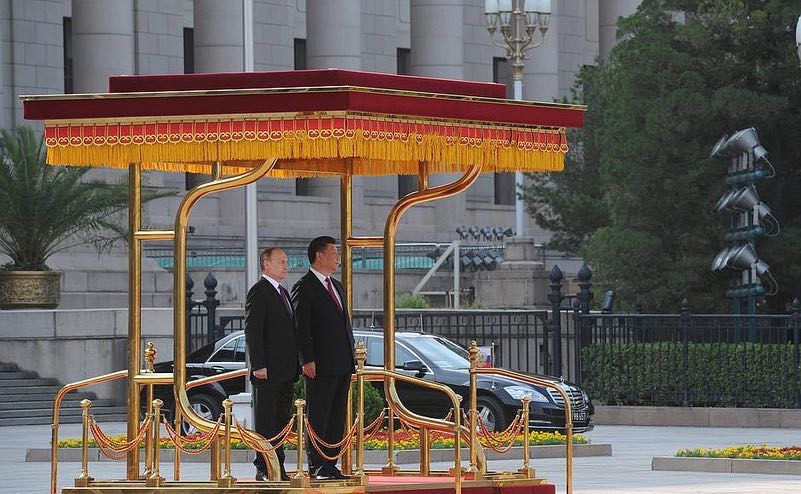In June Putin visited China to sign numerous gas and oil contracts. The results were so far limited.Russia strengthened its position on the Chinese and Indian markets, but the financial relations stagnate. Russia’s trade with China fell as much as 26 percent in 2015 to $68 billion (€61.2 billion), a far cry from the $100 billion (€90 billion) goal.

Poetin en Xi tijdens hun ontmoeting in Beijing. Foto Kremlin.ru
door Sijbren de Jong
Russian president Vladimir Putin paid a high-level visit to China, end of June. Following the meeting, news emerged that Russian and Chinese companies inked more than 30 cooperation accords in the areas of energy, finance, trade, media and sports.
From a PR point of view this is good news for the Kremlin, which is keen to show to the world that it still has powerful friends despite having been shunned by the West.
However, as is more often the case when Russian-Chinese cooperation is concerned, the devil is in the details. Most of the agreements concern framework accords, meaning that concrete cooperation still needs to be finalised.
Well over two years into Putin’s proclaimed 'pivot to Asia', these summits mostly serve as a disguise for underlying difficulties in the bilateral relationship.
Bilateral trade is down
A brief look at trade figures shows that the partnership has not exactly been blossoming. In fact, Russia’s trade with China fell as much as 26 percent in 2015 to $68 billion (€61.2 billion), a far cry from the $100 billion (€90 billion) goal.
To add to the misery, China itself is struggling with slow growth, rising debt and capital outflows. This means Beijing has bigger problems to worry about than to come to Russia’s aid. Moreover, after driving a hard bargain on many of the initial bilateral deals, Chinese investors have been put off by the depth of Russia’s recession.
Establishing sound financial relations is also proving difficult. Illustrative is the fact that in 2015 not a single Russian company carried out a public offering on Asian exchanges.
Energy cooperation
Cooperation in the energy sector is turning out to be a bit of a mixed bag. On the positive side, in March 2016 Russia surpassed Saudi Arabia as China’s biggest oil supplier.
In March 2016, Rosneft agreed to a deal in which a group of three Indian companies took a combined 29.9 percent share in Rosneft’s subsidiary Taas-Yuriakh Neftegazodobycha and a 23.9 percent stake in Vankorneft, the company operating the Vankor field.
On 19 June, news emerged that Putin was considering selling off a 19.5 percent share of Rosneft itself to China and India. If a deal were to materialise, this would help Russia to plug a significant hole in its state budget.
The picture in the natural gas market is less rosy, however. One of the first casualties of changing energy market circumstances was the planned liquefaction plant in Vladivostok.
Given that liquid natural gas (LNG) supplies have mushroomed over the past few years, one could say that Gazprom’s timing in constructing this plant was less than fortunate. In scrapping the plant, Gazprom stated it would focus on supplying China by pipeline instead.
Although, gas pipeline cooperation between Russia and China appeared to have gotten off to a good start when Gazprom announced a $400 billion (€360.15 billion) gas deal with CNPC in March 2014, here too things quickly changed.
Initially eying a finance package worth $25 billion (€22.5 billion), in the form of prepayments for natural gas or loans, for building the necessary Power of Siberia pipeline, Gazprom only managed to secure $2 billion (€1.8 billion) from the Bank of China.
Gas-project in doubt
Aware of the risks associated with investing in Russia’s economy, Beijing pushed for interest rates that were far higher than what Moscow was willing to accept. After already having been given a raw deal on the gas price due to tough Chinese negotiating, the precipitous decline of the price of oil did the rest. The financial viability of the project is now seriously in doubt.
Add to this that Chinese natural gas demand grew at its slowest pace in 17 years in 2015 and Gazprom’s China plans more and more look like just that: dead words on paper.
A $12 billion (€10.8 billion) investment from two Chinese state-owned banks in the Yamal liquefaction plant in the Russian arctic notwithstanding, the real lock-in in a bilateral relationship is not created through LNG, but rather through long-term pipeline deals.
Putin knows this. Much to the Kremlin’s chagrin, this is precisely where the Russian-Chinese partnership is so far failing to deliver.
China knocking on Central Asia’s door
Although Russia still controls the majority of the energy exports emanating from Central Asia, its economic grip on the region is rapidly weakening.
Countries such as Kazakhstan and Turkmenistan were quick to turn to China as an alternative market and now ship significant volumes of oil and gas to the East.
The billions of dollars in Chinese investment available under Beijing’s "One Belt one Road" (OBOR) initiative is seen as attractive compared to Russia’s economic downturn and the Kremlin’s restrictive trade measures on Western agricultural goods.
Xi Jinping’s visit to Iran in January could also be an ominous sign for Russia’s Eurasian Economic Union (EEU).
Adding Iran to the OBOR initiative effectively means that China acquired the possibility of crossing Eurasia without having to go through Russia.
Whereas the EEU appears primarily set up to establish control over its members and to prevent them from taking geo-economic decisions deemed unfavourable by the Kremlin, the OBOR initiative by contrast has a strong outward vision aimed at fostering trade ties.
It has been much more successful to date at creating economic integration than the EEU.
It is telling that not much follow-up occurred after last year’s pompous announcement that the EEU would link up to China’s OBOR initiative. Perhaps what is happening is that, while China is going full steam ahead, Russia’s Asia pivot is slowly running out of that same steam.
